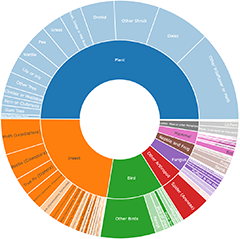Other black fungi <hysterothecial>
The bulk of the fungi in this sub-group produce hysterothecia as fruitbodies. A hysterothecium looks like a pair of black lips, no more than a few millimetres long. An individual hysterothecium is very hard to spot but hysterothecia usually turn up in large colonies. That makes spotting a little easier, but not guaranteed. A colony of a hundred fruitbodies may still occupy no more than a square centimetre or two.
One hysterothecial species, Glonium circumserpens, occurs on soil.
Announcements
There are currently no announcements.
Discussion
Heino1
wrote:
17 Jun 2024
I collected the material photographed here and the identification is based on a look at the spores. The material has been lodged as collection HL6788 at the herbarium in Canberra.
Anteaglonium parvulum
Heino
wrote:
26 Jul 2017
In the leftmost of the inset spore images in Photo 2 you see a pale immature spore. The mature spores have a deep colour and each has a swollen cell (alongside the slight, near-central pinched in part of the spore wall), a feature of the genus. Spores in this specimen measured 36-50 x 10-12 microns.
Oedohysterium sinense
Heino
wrote:
22 Jul 2017
The spores shown in the two inset photos are still within asci.
Hysterobrevium mori
Heino
wrote:
18 Jul 2017
These were on a well-weathered wooden power pole. The inset in Photo 2 shows a close view of a fruit body and you see red colouring along the apical groove. A similar colouration is visible in a number of fruit bodies. At the top left in Photo 3 you see dull reddish-crimson pigment exuding from a fruit body that has ben placed in a drop of potassium hydroxide. In this exudate and the spore features (colour, size and shape) this specimen matches that of sighting http://canberra.naturemapr.org/Community/Sightings/Details/3378766, but in the latter I didn’t notice such a red colour in the groove. However, the apical grooves in the latter were more tightly closed. The red colour in the apical groove suggests the genus Rhytidhysteron.
Hysterobrevium ‘red pigment’
Heino
wrote:
17 Jul 2017
On a well-weathered wooden fence post. Photo 2 shows several spores in a potassium hydroxide (KOH) solution. The size range of the 25 measured spores was 21.6-28.0 x 8.8-12.4 microns. Photo 3 shows the entire sample collected for the herbarium. On the left side of Photo 4 you see a broken fruit body (on a slide in a drop of KOH and after the cover slip has been pressed a bit). On being placed in KOH the fruit body immediately exuded a reddish-crimson pigment, which looks more reddish-brown as it diffuses further into the KOH. On the right is a view, through a microscope, of part of that broken fruit body. Much of that view shows red pigment, but the upper and lower right are still colourless, the pigment not yet having been able to diffuse into those areas.
Hysterobrevium ‘red pigment’


